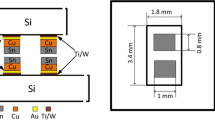Abstract
The influence of wafer bonding and post-bond annealing conditions on the (cavity) void size and distribution was investigated theoretically and verified experimentally. Based on Cu–Cu thermo-compression bonding at 175 °C for 30 min and subsequent annealing at 200 °C for 1, 6 and 24 h, respectively, in both cases the total void surface reduces with the duration of the heat treatment, showing good correlation between theory and experiment. However, the experimental results revealed that the average void size increases while voids number decreases, which is a deviation from the prediction of the physical model.








Similar content being viewed by others
References
Aoki M, Hozawa K, Takeda K (2010) Presented at IEEE International 3D Systems Integration Conference 3DIC in Munich
Baum M, Hofmann L, Wiemer M, Schulz S, Gessner T (2013) Presented at International Semiconductor Conference Dresden-Grenoble ISCDG in Dresden
Gondcharton P, Imbert B, Benaissa L, Verdier M (2014) Voiding phenomena in copper-copper bonded structures: role of creep. ECS Trans 64(5):357–367
Lhostis S, Farcy A, Deloffre E, Lorut F et al. (2016) Presented at Electronic Components and Technology Conference ECTC in Las Vegas
Lifshitz IM, Slyozov VV (1961) The kinetics of precipitation from supersaturated solid solutions. J Phys Chem Solids 19(1–2):35–50
Malik N, Schjølberg-Henriksen K, Poppe E, Visser Taklo MM, Finstad TG (2014) Al Al thermocompression bonding for wafer-level MEMS sealing. Sensor Actuat A Phys 211:115–120
Martinez M, Legros M, Signamarcheix T, Bally L, Verrun S, Di Cioccio L, Deguet C (2013) Mechanisms of copper direct bonding observed by in-situ and quantitative transmission electron microscopy. Thin Solid Films 530:96–99
Mehrer H (Ed) (1990) Landolt-Börnstein 26, diffusion in solid metals and alloys. Springer, Berlin, Sect. 12.2.1, p 641
Mehrer H (2007) Diffusion in solids: fundamentals, methods, materials, diffusion-controlled processes. Springer, New York, 654p
Razavi-Tousi SS, Yazdani-Rad R, Manafi SA (2012) A model for abnormal grain growth in nano-crystalline materials based on zener drag force. Arch Metall Mater 57(1):79
Rebhan B, Hingerl K (2015) Physical mechanisms of copper-copper wafer bonding. J Appl Phys 118:135301
Rebhan B, Hesser G, Duchoslav J, Dragoi V, Wimplinger M, Hingerl K (2012) Low-temperature Cu-Cu wafer bonding. ECS Trans 50:139
Svoboda J, Fischer FD (2014) Abnormal grain growth: a non-equilibrium thermodynamic model for multi-grain binary systems. Model Simul Mater Sci Eng 22:015013-1–015013-15
Svoboda J, Fischer FD, Fratzl P (2006) Diffusion and creep in multi-component alloys with non-ideal sources and sinks for vacancies. Acta Mat 54(11):3043–3053
Tan CS, Reif R, Theodore ND, Pozder S (2005) Observation of interfacial void formation in bonded copper layers. Appl Phys Lett 87:201909
Author information
Authors and Affiliations
Corresponding author
Rights and permissions
About this article
Cite this article
Rebhan, B., Svoboda, J. & Panholzer, M. A thermodynamic study of voiding phenomena in Cu–Cu thermo-compression wafer bonding. Microsyst Technol 24, 815–822 (2018). https://doi.org/10.1007/s00542-017-3523-5
Received:
Accepted:
Published:
Issue Date:
DOI: https://doi.org/10.1007/s00542-017-3523-5




